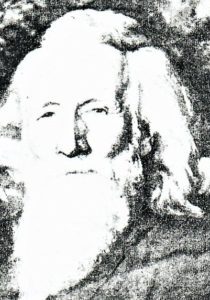History
Memorable Events
Bratenahl's Street Lamplighter

Bratenahl’s street lamps ceased to get personal attention in 1922. Aaron Williams rode from lamp post to lamp post through the dawns and dusks of twenty-five Bratenahl years retired at over 70 years of age after serving twenty-four years. He died seven years later, on April 2, 1929, at age eighty-two.
Before the automobile's advent, he drove under the tree-spanned streets in with his faithful horse Molly and his green, two-wheeled lamp cart with “Lamplighter” printed on the rear, the reins in one hand, and an old-fashioned gasoline flare in the other. He tended to the gas lights on village streets and private gas lights on some estates' driveways.
To see the flare floating down the road in darkness with a long trail of lighted lamps in its wake and to hear the slow rumble of the cart’s wheels on hard-packed clay was an event that touched the imagination of two generations of children.
Molly knew every lamp along the boulevard. She crisscrossed without a “giddap” or “whoa.” Aaron was so fond of Molly that when it came time to replace her, he said, "I wouldn't part with her for the world, not even if all the folks out there chipped in and bought me a $5,000 machine. Molly deserves a good rest in her old age, and she's going to have it."

Molly was replaced by a Model T Ford that couldn’t go about its business independently as the little horse did. When Aaron retired, he moved the automobile to a place of honor in his yard as though it was a faithful horse.
Aaron Williams was a red-cheeked, ever-cheerful, warm-hearted lighter of lamps. He was a village character, a sort of unofficial town crier. No matter what the weather, he was on the job always cheery in returning greetings. The children who followed him on his rounds called him Santa Claus for his long white hair and beard. They were amazed that he never ignited his beard with the flame from the naphtha torches he carried from lamp to lamp.
Colonel Aaron Williams, an old Indian scout who worked with Buffalo Bill, was born on February 11, 1847. He came to the village in 1898 from Bay City, Michigan. After a few months, everybody knew him. He had a vigorous interest in everything about the village and knew all by their first names. He knew all the children and adults of the old families. He called to them, talked to them, and told them stories. He knew of every family event of births, deaths, weddings, and accidents.
When Williams began work in what was known as Glenville on the Lake, he had fifty lamps to take care of. He received $1 per lamp. In 1905, a resolution was presented to the council declaring it necessary to light all streets within the Village. Lake Shore Boulevard was unpaved and arched by tall oaks, sycamores, and elms. Side streets were lanes.
Council signed a contract with Canton, Ohio’s Sun Vapor Light Company, to furnish and maintain not less than 121 gas Weisbach Street Lights. The number of lamps increased to 200. Williams made two rounds of his 200 lamps per day, starting at 4:00 in the morning.
Williams reflected, "Tending lamps isn't such a monotonous occupation as it sounds. I've narrowly escaped death several times in runaways and automobile crashes." But even while recovering from injuries received in these accidents, Williams was faithful to his trust and never missed more than two or three days at best.
The green lamp and clear glass lanterns were owned by the Weisbach Gas Mantle Co of Philadelphia. The company supplied the gas mantles and rented the streetlights. An assessment of property owners covered the costs of the standards, globes, and installation. Street lamps were placed 150 feet apart throughout the village. To make sure full value was received, the council added a nightly inspection of the gas lights to Marshal Newkirk’s duties.
Six-day Clockworks replaced William’s manual work for Cleveland Streetlamps to turn the gas on and off. The mantles still had to be replaced, and the clock wound. By custom, the old mantles were given to the first child to ask for them.
As a lasting reminder of the gaslights, Roberta Bole presented to the Village a painting of “The Lamplighter” by Cora Holden. Cora was an instructor at the Cleveland School of Art and a relation of Liberty Holden. It was displayed at the May Show at the Cleveland Museum of Art. At the suggestion of Mrs. Bole, the council adopted a resolution that in the event of a merger with Cleveland, the painting should be returned to Cora Holden rather than sold or disposed of in some other matter.
In 1948, The Village announced that 153 gas street lights, which had given Bratenahl part of its character since 1905, would be replaced with 123 modern electric street lights. Surveys by lighting engineers showed that the amount of illumination by the old gas lamps was not sufficient at the pavement level to register on a light meter. The gas lights, owned by the Weisbach Gas Mantle Co. of Philadelphia, were sent to Philadelphia, which still used gas lamps.
